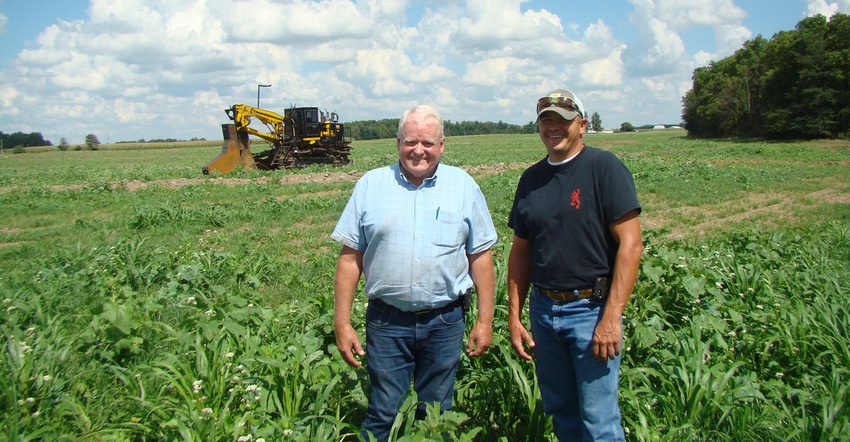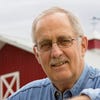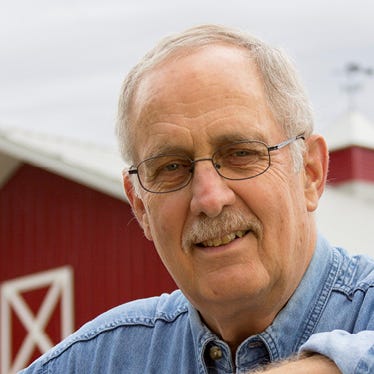November 21, 2018

Randolph County, Ind.’s Bob Chalfant is doing what he was once told couldn’t be done.
“At Purdue University I majored in agronomy, and at that time, our professors told us that you couldn’t change soil organic matter or cation exchange capacity any appreciable amount in your lifetime,” he recalls. “At that time, with the way we farmed then, they were correct. But due to our [current] soil health practices, we’re making significant strides in improving both the organic matter and the CEC in our soils.”
Chalfant has been an early adopter throughout his farming career. In 1987 he was farming with his father, Lee, and his brother Tom. They no-tilled a 37-acre field of soybeans, liked what they saw, and promptly had an auction for their conventional tillage equipment.
Fast-forward a few years. For next spring, Chalfant’s son Ryan is putting together a corn planter that will automatically vary varieties and populations, based on a sensor that tells the planter the soil type, amount of organic matter, moisture, soil temperature and amount of residue in the row.
About eight years ago, Chalfant and his son tried cover crops, and have been planting them on 100% of their acres for the past six years. Some are drilled while some are flown into standing crops. They’ve added some wheat to their corn-soybean rotation to help improve their carbon-to-nitrogen ratios. And they are currently in the process of installing pattern drainage on their farms. While these practices have helped the Chalfants achieve better and more consistent yields, their focus is on the long view of building their overall soil health.
Numbers tell story
The Chalfants farm by soil type-based management zones, developed using soil electrical conductivity data and ground-truthed soil variation mapping, which is proprietary technology of Reynolds Agronomy. This service is part of Reynolds Farm Equipment, Fishers, Ind., with locations in Indiana, Ohio and Kentucky.
Chalfant describes Randolph County as basically a clay-loam county. From 2016 to 2018, all but one of 14 zones in two sample fields from the Chalfants’ home farm showed increases in soil organic matter, up to a maximum of 1.2% in one zone. The average increase in soil organic matter for one field was 0.5%, and the other was 0.33%. The darker soils in the fields now average 4.8% soil organic matter, while the lighter soils average 3.3%.
To obtain these results, composite soil sampling was used within the zones, and core locations were recorded and duplicated. All fields received a regular fertilizer program, plus some gypsum. Mark Truster, managing agronomist with Reynolds Ag Technology Solutions Department, says the Chalfants are definitely improving their soils with no-till and cover crops.
“In a two-year period, from 2016 to 2018, almost all their organic matter levels have risen, and most of their CEC calculations have risen also,” Truster says. “This is real progress in a short time. Bob and Ryan have raised their organic matter levels to some of the highest we see in central Indiana.”
Organic matter pays
The Chalfants say increasing soil organic matter produces a multitude of benefits, a chief one being increasing the water-holding capacity of the soil.
“Every percent of soil organic matter you add gives your soil the ability to hold an additional inch of rain,” Chalfant says. “An inch of rain equates to about 25,000 gallons of additional water, and in a dry year, that’s a lot of water. And if you’ve increased your organic matter 2%, that’s twice as much water.”
Chalfant says using cover crops has enabled them to cut back on chemical usage. He and his son are also planning to cut back on the use of dry fertilizer and to start using some hog manure and chicken litter, partly to help build organic matter even faster. He says planting cover crops is an integral part of growing soil organic matter.
“Most people don’t realize that there are more life forms — bacteria, fungi, soil microbes, worms — in a teaspoonful of healthy soil than there are people in the world,” Chalfant says. “That’s hard to get your head around. But that’s the reason we grow cover crops, because all those life forms have got to have something to eat, which is why we try to keep something growing all year. We need to have those life forms to feed our crops.”
While building soil health and getting better yields are important and satisfying, the Chalfants say they have an even more important reason for practicing good soil health.
“Our philosophy is that we want to get the soil back to the way God gave it to us,” Chalfant says. “That’s what we’re trying to do.”
Boone writes from Wabash, Ind.
About the Author(s)
You May Also Like






